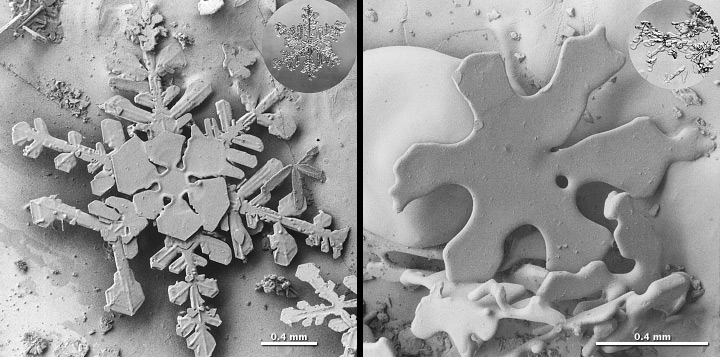博文
格陵兰岛的冰正在变暗
||
http://earthobservatory.nasa.gov/IOTD/view.php?id=76916  获取时间: 2011.7-8.31
获取时间: 2011.7-8.31
在过去,格陵兰岛明亮的表面可以反射一半以上照在上面的太阳光。这种反射特性可以吸收很少的太阳光,减少冰川的热量以及消融,从而有助于保持格陵兰岛的稳定。然而,在过去的几十年里,我们通过卫星观测到冰川的反射率的降低。冰面的不断变暗,使得其吸收更多的太阳光,而这正加速了冰川的消融。
上图所展示的是格陵兰岛所反射的太阳光的照射量在2011年夏天于2000年-2006年的平均反射量得差异百分比。事实上,整个格陵兰冰盖显示出了一些变化,与几十年前相比,有些区域冰川的明亮度减少了20%。上图这幅图是通过搭载在terra和aqua卫星上的中分辨率成像光谱仪(MODIS)获得的,同时这张图也是作为美国国家海洋和大气管理局的Arctic Report Card.的一部分出现的。
气候学家已经长期预测到,随着全球气温的升高,地球两极的区域的反射率会降低。温度的升高会融化更多的冰和雪,没有冰雪覆盖的地形(水体、植被、裸露的地面)变的更暗,会吸收更多的太阳光。然后,反射率的降低又增加了最开始的变暖。
图上大部分的类型是与预计的相符合。比较暖的、低纬度的区域比冷的、高纬度的区域变的更暗。在每一个夏天,冬天的雪都会在冰盖的边缘开始退缩。冰川表面的融水坑、沙尘以及冰川表面的其他颗粒都会降低冰川的反射率。
根据Ohio State University的Jason Box 分析的反射率数据可知,冰盖的内部发生了与边缘的一样明显的变暗。冰川的内部是处于冰川搞的位置(海平面以上2米),并且没有发现冰盖在夏季消融。但为什么冰盖的内部会变暗呢?
据Box说,这种变暗是由于雪块中冰晶体的形状和尺寸决定的。当温度上升时,许多雪颗粒聚集到一起,这样这些聚集的颗粒比多面的小晶体就会变的不明亮。边缘规则的颗粒以及圆形的颗粒比边缘参差不齐的颗粒吸收更多的太阳光。
- References
- NOAA ClimateWatch Magazine (2011, December 1) Highlights of the 2011 Arctic Report Card. Accessed January 9, 2011.
- NOAA (2011) Arctic Report Card: Update for 2011. Accessed January 9, 2011.
Map by NOAA’s climate.gov team, based on NASA satellite data processed by Jason Box, Byrd Polar Research Center, the Ohio State University. Caption adapted from a story by Rebecca Lindsey, NOAA ClimateWatch.
原文:
In the past, the bright surface of the Greenland Ice Sheet reflected well over half of the sunlight that fell on it. This reflectiveness helped keep the ice sheet stable, as less absorbed sunlight meant less heating and melting. In the past decade, however, satellites have observed a decrease in Greenland’s reflectiveness. This darker surface now absorbs more sunlight, which accelerates melting.
The map above shows the difference between the amount of sunlight Greenland reflected in the summer of 2011 versus the average percent it reflected between 2000 to 2006. Virtually the entire ice sheet shows some change, with some areas reflecting close to 20 percent less light than a decade ago. The map is based on observations from the Moderate Resolution Imaging Spectroradiometer(MODIS) instruments on NASA’s Terra and Aqua satellites. It was produced as part of the National Oceanic and Atmospheric Administration’s Arctic Report Card.
Climate scientists have long expected that Earth’s polar regions will become less reflective as global temperatures rise. Rising temperatures melt snow and ice, and the uncovered terrain—water, vegetation, bare ground—is darker and absorbs more sunlight. The loss of reflectiveness then amplifies the initial warming.
Most of the patterns on the map fit expectations. Warmer, lower-elevation areas of the ice sheet have darkened more than the colder, higher-altitude interior. Each summer, winter snow retreats from the edge of the ice sheet. Dark pools of melt water form on the surface of the ice, and windblown dust and other particles also collect near the surface, making it even less reflective.
But the darkening in the interior is just as remarkable as the changes at the margins, according to Jason Box of Ohio State University, who analyzed the reflectiveness data. The interior is the high point of the ice sheet, nearly two miles above sea level, and there is no visible melting in the summer. So why is the area becoming darker?
The darkening, says Box, is due to changes in the shape and size of the ice crystals in the snowpack. As temperatures rise, snow grains clump together and reflect less light than the many-faceted, smaller crystals (see lower image). Additional heat rounds the sharp edges of the crystals, and round particles absorb more sunlight than jagged ones.
https://wap.sciencenet.cn/blog-564327-527845.html
